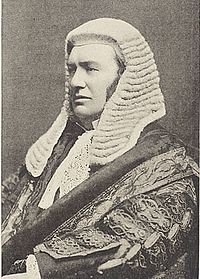- Nathaniel Lindley, Baron Lindley
-
Sir Nathaniel Lindley, Baron Lindley SL PC FRS (29 November 1828 – 9 December 1921) was an English judge.
Biography
He was the second son of the botanist John Lindley, born at Acton Green, London. He was educated at University College School, and studied for a time at University College, London. He was called to the bar at the Middle Temple in 1850, and began practice in the Court of Chancery. In 1855 he published An Introduction to the Study of Jurisprudence, consisting of a translation of the general part of Thibaut's System des Pandekten Rechts, with copious notes. In 1860 he published in two volumes his Treatise on the Law of Partnership, including its Application to Joint Stock and other Companies, and in 1862 a supplement including the Companies Act 1862. This work has since been developed into two textbooks well known to lawyers as Lindley on Companies and Lindley on Partnership.
He became a Queen's Counsel in January 1872. In 1874 he was elected a bencher of the Middle Temple, of which he was treasurer in 1894. In 1875 he was appointed a justice of the Court of Common Pleas, the appointment of a chancery barrister to a common-law court being justified by the fusion of common law and equity then shortly to be brought about, in theory at all events, by the Judicature Acts.
In 1875, he was appointed a Knight Bachelor. In 1880 he became a justice of the Queen's Bench and in 1881 he was raised to the Court of Appeal of England and Wales and made a Privy Councillor. In 1897, Lord Justice Lindley succeeded Lord Esher as Master of the Rolls, and in 1900 he was made a Lord of Appeal in Ordinary with a life peerage and the title of Baron Lindley, of East Carleton in the County of Norfolk. He resigned the judicial post in 1905.
Lord Lindley was the last serjeant-at-law appointed, and the last judge to wear the serjeant's coif, or rather the black patch representing it, on the judicial wig.
He married Sarah Katharine, daughter of Edward John Teale of Leeds, on 5 Aug 1858.[1] He died at home in East Carleton, near Norwich in 1921.
Cases
- Knox v Gye (1872)
- Creen v Wright (1875–76) LR 1 CPD 591
- Parker v South Eastern Railway (1877) 2 CPD 416
- Byrne v Van Tienhoven [1880] 5 CPD 344
- Speight v Gaunt (1883) 9 App Cas 1
- Isle of Wight Railway Company v Tahourdin (1884) LR 25 Ch D 320
- In re Addlestone Linoleum Co (1887) 37 Ch D 191
- Allcard v Skinner (1887) 36 Ch D 145
- In re Whiteley (1886) 33 Ch D 347 , 355
- Robinson v Kilvert (1889) LR 41 ChD 88
- Carlill v Carbolic Smoke Ball Co [1892] QB 408
- Salomon v Salomon [1897] AC 22
- South Hetton Coal Co v Haswell, Shotton and Easington Coal and Coke Co [1898] 1 Ch. 465
- Allen v Gold Reefs of West Africa Ltd [1900] 1 Ch 656
- Taff Vale Railway Co v Amalgamated Society of Railway Servants [1901] AC 426
- Quinn v Leathem [1901] AC 495
- Scottish Free Church case [1904] AC 515
- Colls v Home and Colonial Stores (1904)
- Shepheard v Broome [1904] AC 342
References
 This article incorporates text from a publication now in the public domain: Chisholm, Hugh, ed (1911). "Lindley, Nathaniel Lindley, Baron". Encyclopædia Britannica (11th ed.). Cambridge University Press.
This article incorporates text from a publication now in the public domain: Chisholm, Hugh, ed (1911). "Lindley, Nathaniel Lindley, Baron". Encyclopædia Britannica (11th ed.). Cambridge University Press.- L. G. Pine, The New Extinct Peerage 1884–1971: Containing Extinct, Abeyant, Dormant and Suspended Peerages With Genealogies and Arms (London, U.K.: Heraldry Today, 1972), page 178.
Legal offices Preceded by
Viscount EsherMaster of the Rolls
1897–1900Succeeded by
Lord AlverstoneCategories:- 1828 births
- 1921 deaths
- Law lords
- English judges
- People from Acton, London
- Old Gowers
- Serjeants-at-law
- Members of the Middle Temple
- Queen's Bench Division judges
- Masters of the Rolls
- Members of the Judicial Committee of the Privy Council
- Fellows of the Royal Society
- Justices of the Common Pleas
Wikimedia Foundation. 2010.

